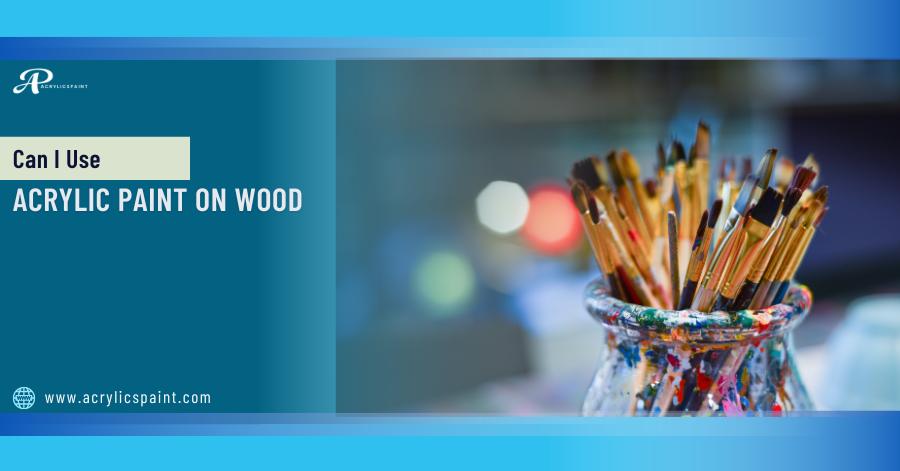Acrylic paint is a popular choice among art and DIY enthusiasts for its vibrant colours, quick drying time, and ease of use. But many people are curious to know, “Can I use acrylic paint on wood?” The short answer is yes!
Painting with acrylics can be an excellent choice for your craft projects as it adheres well to wood surfaces such as pine, oak, and birch. However, you should know a few things to ensure the best results.
Before we start, let’s quickly look at the do’s and don’ts of acrylic painting on piece wood.
Do’s:
- Do Clean and Sand the Surface Before Applying Acrylics
- Do Use a Primer
- Do Work in Thin Layers
- Do Experiment with Techniques
- Do Seal the Wood Paint
Don’ts:
- Don’t Skip Surface Preparation
- Don’t Use Too Much Pain
- Don’t Rush the Drying Process
- Don’t Forget to Protect Your Workspace
- Don’t Overlook Ventilation
Using Acrylic Paint on Wood
When painting on wood with acrylics, you can take a few steps to achieve the best outcome.
Preparation of the wood surface
Before starting your painting project, preparing the surface properly is essential. Start sanding and cleaning the wood to create a texture-free surface and smoothness to which the paint can adhere. This step helps prevent imperfections or rough patches from affecting the final result.
Primer for Acrylic Paint on Wood
Using a primer specifically designed for acrylic paint will enhance the adhesion and longevity of your artwork. Apply a thin, even coat of primer, such as gesso or acrylic primer, to the wood surface and allow it to dry completely before proceeding with your painting.
APPLYING ADDITIONAL COATS
Add more layers of primer, gently sanding in between each layer to even out the surface. When you’re happy with the surface, you can start applying acrylic paint.
Ensure you apply the paint in thin layers and gradually build them up for optimal outcomes.
GATHERING SUPPLIES
Gather your paint supplies to begin painting:
- Acrylic paint
- Paintbrushes
- Palette
- Water container
- Palette knife (optional)
- Sandpaper
- Primer (optional)
- Sealant or varnish (optional)
- Drop cloth or newspaper.
Painting Technique
You can apply acrylic paint using various techniques, including brushwork, pouring, or airbrushing. Try out different methods to achieve the desired effects for your project. Work in thin layers for smoothness, allow each coat to dry and add additional layers for optimal results.
Sealing Acrylic Paint on Wood
Once your masterpiece is complete, it’s crucial to seal the acrylic paint to protect it from damage and ensure its longevity. Several options for sealing acrylic paint on wood include varnishes, sealers, and clear coats.
It’s crucial to prepare the surface properly for successful acrylic painting on wood. Start by smoothing the wood through sanding, and for more uneven surfaces, use a primer prior to painting.
What to Use to Seal Acrylic Paint on Wood
When choosing a sealant for your acrylic paint on wood crafts, opt for a product specifically formulated for this purpose. Look for clear coats or varnishes designed for acrylics, as these will provide a durable and protective finish without yellowing over time.
Clear Coat for Acrylic Paint on Wood
While many clear coat options are available, some popular choices among artists include polymer, acrylic sealers, and epoxy resin. Each type of sealant offers different levels of protection and finishes, so be sure to select the one that best suits your needs and preferences.
Acrylic Painting options for wood
Advanced Adhesion Formulas
New acrylic paint formulations feature advanced adhesion agents that seamlessly bond with wood surfaces, ensuring durability and minimizing peeling or cracking.
Low-Odor and Eco-Friendly Options
Manufacturers now offer low-odour, environmentally-friendly acrylic paints for wood free from harmful VOCs, making them safe for indoor use without compromising performance.
Enhanced UV Protection
Some acrylic paints now include UV-resistant additives, which protect against sun damage and maintain vibrant colours on outdoor wood surfaces.
Specialty Effects and Finishes
Specialized acrylic paints for wood offer unique effects, such as textured finishes mimicking wood grain, metallic hues, and glow-in-the-dark options.
Quick-Drying Formulations
Quick-drying acrylic paints reduce drying time between layers, enabling faster project completion and minimizing the risk of smudging. They are ideal for intricate designs.
Tips and Tricks for Painting on Wood
- Surface cleaning is essential. Use a damp cloth to remove dust, dirt, or grease.
- Lightly sand the surface before painting the wood to create a smooth base.
- Choose a primer specifically designed for acrylic paint on wood.
- Use a brush or roller to apply the primer evenly.
- Experiment with brushing, sponging, or spraying techniques to achieve various effects.
- Work in thin layers, gradually building the colour to avoid clumping and ensure even coverage.
- Select a clear coat or varnish for acrylic paint on wood to protect your artwork.
- Use a paint roller or brush to apply the sealant and let it dry completely before handling.
- Allow each layer of paint and sealant to dry thoroughly before proceeding.
- For a worn-out or aged look, you can gently sand the painted area or employ a dry brushing method to generate a distressed finish. Enjoy the process of painting on wood, and don’t be afraid to get creative with colours and techniques.
- Clean your brushes and painting tools with warm, soapy water immediately after use to prolong their lifespan.
- Dispose of any leftover paint or solvents responsibly, following local regulations.
By following these tips and tricks, you can achieve stunning results when painting on wood surfaces while enjoying a fun and rewarding artistic experience!
Conclusion
In conclusion, yes, you can use acrylic paint on wood! With proper preparation, painting techniques, and sealing methods, acrylic paint can produce stunning results on wooden surfaces. Try painting with acrylics on wood for your DIY projects and learn the process while saving significant money on materials. So grab your brushes, pick up some acrylic paint, and let your imagination soar!














